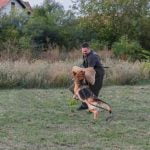Training an old dog to duck hunt may initially sound like a daunting task, but it is far from impossible. In fact, it’s never too late to embark on this adventure with your furry friend. There is a common misconception that older dogs cannot be trained for new skills, but the truth is that dogs of any age can learn and adapt with proper guidance and patience.
Training an old dog for duck hunting comes with its own set of benefits and advantages. These dogs often bring a level of maturity and experience that can prove invaluable in the field. Their calm demeanor and obedient nature can make them excellent hunting companions. Additionally, training an older dog can be a deeply rewarding experience, as you witness their growth and progress throughout the training process.
Before diving into training, it is important to assess your dog’s abilities and limitations. Consider their physical fitness, health, temperament, obedience levels, and previous training experience. This evaluation will help you tailor your training approach to suit your dog’s specific needs and circumstances. While there may be some challenges due to their age, these can be overcome with patience and careful planning.
In the following sections of this article, we will explore in detail the steps involved in training an old dog to duck hunt. From establishing foundational obedience training to conditioning their physical fitness for the demands of hunting, introducing scents and decoys, simulating hunting situations with gunfire exposure, honing retrieval skills through marking drills – we will cover it all.
Ultimately, our aim is to celebrate the successful transition of an old dog into a skilled duck hunting companion while inspiring others to embrace their older dogs’ potential for learning new skills.
Assessing the dog’s abilities and limitations
When considering training an old dog for duck hunting, it is essential to assess the dog’s abilities and limitations. This evaluation will help determine the feasibility of training and create a tailored approach for success. Assessing the dog’s physical fitness and health is crucial in order to provide appropriate training and minimize any potential risks.
First and foremost, consult with a veterinarian to ensure that the dog is physically able to engage in duck hunting activities. The vet can conduct a thorough examination to assess the dog’s overall health, joint mobility, and cardiovascular capacity. It is important to address any underlying medical conditions or concerns before proceeding with training.
Next, consider the dog’s temperament, obedience level, and previous training experiences. Some old dogs may have developed behavioral patterns over time that can impact their ability to learn new skills. Take note of any fears or anxieties the dog may have towards water, loud noises, or other elements commonly encountered during duck hunting. This assessment will help identify areas that require extra attention or conditioning.
Keep in mind that an older dog may have had previous training in various aspects such as basic commands or retrieving skills. Evaluate their proficiency in these areas and use them as building blocks for further training. Dogs with a solid foundation in obedience are more likely to excel in advanced tasks such as retrieving fallen ducks.
Lastly, acknowledge any limitations or challenges that may arise due to the dog’s age. Older dogs may have decreased energy levels or endurance compared to younger counterparts. Adjust the training regimen accordingly by incorporating shorter sessions and gradual increments of exercise intensity.
Assessing the dog’s abilities and limitations sets a strong foundation for successful duck hunting training. A thorough evaluation of their physical fitness, temperament, obedience level, and previous training experiences allows for an individualized approach that caters to their specific needs. By acknowledging any limitations caused by age, trainers can adjust their methods and expectations while still achieving significant progress with older dogs.
Establishing the foundational obedience training
Establishing a strong foundation of obedience training is essential for successfully training an old dog to duck hunt. This section will provide step-by-step guidance on teaching basic commands such as sit, stay, recall, and heel. It is important to note that positive reinforcement techniques and consistency in training sessions are highly recommended.
The first step in establishing foundational obedience training is teaching the dog the command “sit.” Begin by holding a treat close to the dog’s nose and slowly raise it above their head. As their head follows the treat, their bottom should naturally lower into a sitting position. Once they are sitting, praise and reward them with the treat. Repeat this exercise several times until they understand the command.
The next command to introduce is “stay.” Start by commanding the dog to sit, then place your open hand in front of their face while saying “stay.” Take one or two steps back and return immediately to reward them for staying in place. Gradually increase the distance as they become more comfortable with staying in position.
Recall training is crucial for duck hunting, as you need your dog to come back to you reliably. Begin this training by putting your dog on a long leash or harness and walking away from them. Use an enthusiastic tone of voice and call their name followed by “come.” When they come towards you, reward them with praise and treats. Practice this exercise in various environments to ensure reliable recall.
Finally, teaching your old dog to heel will help keep them focused during hunts and prevent distractions. Start by getting your dog into a sit position beside you. Hold a treat near their nose and begin walking forward while giving the command “heel.” Keep the treat close to your leg so that they stay right beside you throughout the walk. Praise and reward them intermittently for maintaining proper heeling position.
Consistency is key when establishing foundational obedience training. Set aside short but frequent training sessions every day to reinforce these commands. Use positive reinforcement techniques such as treats, praise, and affection whenever your dog successfully performs a command.
| Command | Description |
|---|---|
| Sit | Teaches the dog to put their bottom on the ground when commanded. |
| Stay | Teaches the dog to remain in their current position until given further instruction. |
| Recall | Teaches the dog to come back to you when called. |
| Heel | Teaches the dog to walk calmly and close beside you without pulling or straying. |
Conditioning the dog for the physical demands of duck hunting
Conditioning is a crucial aspect of training an old dog for duck hunting. Before introducing the dog to any specific hunting skills, it is important to ensure that they are physically fit and capable of handling the demands of this activity. Here are some key steps to consider when conditioning your dog for duck hunting:
Assess the dog’s current fitness level
Before starting any strenuous exercises, it’s important to evaluate your dog’s overall health and physical condition. Consult with your veterinarian to assess any potential limitations or health concerns that may require modifications in training. Consider factors such as age, weight, joint health, and cardiovascular endurance.
Start with low-impact exercises
To gradually build up your dog’s stamina and endurance, begin with low-impact exercises such as walking or swimming. These activities will help improve muscle tone and cardiovascular fitness without putting excessive strain on their joints.
- Start with shorter walks or swims initially, then gradually increase the duration over time.
- Incorporate different terrains like sandy beaches or uneven terrain to simulate hunting conditions.
Incorporate field training exercises
Once your dog has built a basic level of fitness, it is important to incorporate field training exercises into their routine to simulate hunting conditions more accurately:
- Set up simulated retrieves in different environments (e.g., water retrieves, land retrieves across various terrains).
- Use decoys and waterfowl scents during these mock hunts to help familiarize your dog with the smells and sights they will encounter during actual duck hunts.
- Gradually increase both the distance and difficulty level of retrieves, challenging your dog’s abilities while ensuring they experience success.
It is essential to monitor your old dog closely during conditioning exercises to avoid overexertion or injury. A consistent and progressive training regimen, tailored to your dog’s abilities and limitations, will ensure they are physically capable of meeting the demands of duck hunting.
Introducing the dog to waterfowl scents and decoys
In order to become a successful duck hunting companion, it is important to introduce your old dog to waterfowl scents and decoys. This step helps develop their tracking skills and builds their association between hunting and retrieving. By gradually familiarizing them with these elements, you can enhance their ability to locate and retrieve ducks during a hunt.
Developing scent tracking skills
One of the key aspects of training an old dog for duck hunting is teaching them how to track the scent of waterfowl. Start by introducing them to different waterfowl scents such as duck feathers or wings. Allow them to sniff and explore these scents while providing positive reinforcement and praise. Gradually increase the difficulty by hiding these scents in various locations, both on land and in water, allowing the dog to navigate their way towards them.
As your dog becomes more comfortable with scent tracking, you can progress to using actual duck dummies soaked in waterfowl scent. Encourage them to retrieve these dummies by tossing them a short distance and gradually increasing the distance over time. This exercise will enhance their tracking abilities while also reinforcing their retrieval skills.
Familiarizing with decoys
Another crucial aspect of introducing your old dog to duck hunting is getting them accustomed to decoys. Decoys are lifelike replicas of ducks that are used during hunts to attract real birds. Begin by setting up a few basic decoys in a controlled environment where distractions are minimized. Allow your dog to investigate the decoys but ensure they understand that they should not disturb or interact with them excessively.
Over time, increase the complexity of the scenario by setting up decoys near water sources such as ponds or lakes. Encourage your dog’s curiosity while simultaneously reinforcing obedience commands such as “leave it” or “no” when they try to interact with the decoys. Keep in mind that some dogs may have a stronger prey drive, so extra patience and consistent training will be necessary.
Simulating hunting scenarios with decoys can also aid in preparing your old dog for real-life hunting situations. Begin by tossing a dummy or a buoyant object near the decoys to simulate a fallen duck. Train your dog to associate these objects with retrieving and bring them back to you. Incorporate commands such as “fetch” or “retrieve” during this process, reinforcing their connection between the objects and retrieving.
By introducing waterfowl scents and decoys, you are preparing your old dog for the sights and smells they will encounter during an actual duck hunt. Building their tracking skills through scent exercises and familiarizing them with decoys will undoubtedly contribute to their success as a dependable duck hunting companion.
Simulating hunting situations and gunfire exposure
Simulating hunting situations and providing exposure to gunfire is a crucial step in training an old dog for duck hunting. This section will discuss the importance of exposing the dog to realistic hunting scenarios, recommend drills and simulations to teach the dog to respond to gunshots without fear or distraction, and highlight the significance of gradual desensitization and positive reinforcement in overcoming any gun-shyness.
When simulating hunting situations, it is important to gradually introduce the dog to different aspects of a typical hunt. Start by setting up simple scenarios in a controlled environment, such as using decoys and hiding scent-drenched objects for the dog to find. As the dog becomes more comfortable with these scenarios, progressively increase the difficulty level by introducing distractions, multiple decoys, and varying environments.
In order to familiarize the dog with gunshots, it is crucial to start with desensitization exercises. Begin by playing audio recordings of gunfire at a low volume while engaging the dog in activities it enjoys, such as feeding or playtime. Gradually increase the volume over time as long as the dog remains calm and relaxed. It is important to always associate these sounds with positive experiences for the dog.
Once the dog has been successfully desensitized to recorded gunfire, move on to more realistic simulations. This can be done by having someone fire blanks from a distance while engaging in activities that excite or engage the dog’s attention. Slowly decrease the distance from which the gunshots are fired until they are at a normal hunting range.
It is important throughout this process to closely observe your old dog’s reactions and make adjustments as needed. Each dog is unique, so some may require more time and patience than others when it comes to acclimating them to hunting situations and gunfire exposure. Always aim for positive reinforcement by rewarding calm behavior with treats or praise.
Retrieval training and marking drills
To begin retrieval training, it is important to establish a strong foundation of obedience training. Make sure your dog has mastered basic commands such as sit, stay, and recall before moving on to retrieving exercises. Start by using objects that are easy for the dog to pick up, such as soft toys or bumpers.
Use positive reinforcement techniques, such as treats or praise, to encourage the dog to fetch the object and bring it back to you. Gradually increase the difficulty by throwing the object farther away or across different terrains.
Once your dog understands the concept of retrieving, you can introduce them to water retrieves if they haven’t been exposed to water before. Find a shallow body of water where your dog can comfortably swim and place a bumper or floating toy in it. Encourage your dog to retrieve the object from the water and return it to you. Repeat this exercise in different bodies of water and gradually increase the distance.
In addition to retrieval training, marking drills are crucial for teaching your old dog how to locate fallen ducks during a hunt. Start by using brightly colored dummies and hiding them in various locations within a predetermined area. Allow your dog to observe where you hide each dummy before sending them out to find it using hand signals or verbal cues. As your dog becomes proficient with single mark retrieves, you can gradually progress to multiple marks or hidden marks.
With consistent practice and positive reinforcement, retrieval training and marking drills will enhance your old dog’s ability to track down fallen ducks efficiently during real hunting situations. Remember that patience is key when working with an older dog, as they may require more time and repetition to learn new skills. By investing in their training, you can transform your old dog into a reliable and effective hunting companion.
- Establish a foundation of obedience training before moving on to retrieval exercises.
- Start with easy retrieves on land using objects like soft toys or bumpers.
- Gradually introduce water retrieves, beginning with shallow bodies of water.
- Incorporate positive reinforcement and gradually increase the difficulty of retrieves.
- Use brightly colored dummies for marking drills and progress to multiple or hidden marks.
Handling blind retrieves and navigating different hunting terrains
The importance of handling blind retrieves
One of the most advanced skills that a duck hunting dog must possess is the ability to handle blind retrieves. In these situations, the dog cannot visually see the fallen bird and relies solely on their handler’s signals and commands to locate and retrieve it. This skill is vital because it allows the dog to retrieve birds that have fallen out of sight, such as in tall grass or dense vegetation.
To develop this skill, it is important to start with basic obedience training and establish a strong foundation of verbal commands and hand signals. The dog should be proficient in following these cues before moving on to blind retrieves. It is also essential to gradually increase the difficulty of the exercise by starting with short distances and simple terrain before progressing to longer distances and more challenging environments.
Training exercises for handling blind retrieves
There are various training exercises that can help improve a dog’s ability to handle blind retrieves. One effective method is using “poison bird” drills, where a dummy or retrieving object is hidden among several decoys or distractions. The handler then uses hand signals and verbal cues to direct the dog towards the hidden object.
Another beneficial exercise is running pattern blinds, where predetermined paths or lines are set up for the dog to follow while seeking out hidden dummies or retrieving objects. This exercise helps develop the dog’s ability to take directions and maintain focus while navigating different terrains.
It is important to remember that consistency, patience, and positive reinforcement are key throughout these exercises. By gradually increasing difficulty levels and rewarding successful retrievals, handlers can help their old dogs build confidence in handling blind retrieves.
Navigating different hunting terrains
Duck hunting often requires dogs to navigate various terrains such as marshes, water bodies, thick brush, or even icy surfaces during winter hunts. Training an old dog to navigate these different terrains is crucial to ensure their safety and efficiency in the field.
Start by introducing your dog to different terrains gradually. Begin with easy environments such as grassy fields or open water before moving on to more challenging areas. Use positive reinforcement to encourage your dog’s confidence and provide additional training aids like boots or protective gear when needed.
To help your dog navigate thick brush or dense vegetation, practice obedience commands that keep them close and focused such as “heel” or “close.” For icy surfaces, consider using traction devices for your old dog’s safety.
Varying the locations of training exercises can also expose your dog to different hunting terrains and challenges, preparing them for real-world hunting scenarios. By practicing in a variety of environments, you can help your old dog adapt quickly and confidently handle any terrain they may encounter during duck hunts.
Conclusion
In conclusion, training an old dog to become a duck hunting companion is not only possible but also incredibly rewarding. Throughout this article, we have debunked the common misconception that older dogs cannot learn new skills and highlighted the numerous benefits and advantages of training an older dog for duck hunting.
By thoroughly assessing the dog’s abilities and limitations, establishing foundational obedience training, conditioning the dog physically, introducing waterfowl scents and decoys, simulating hunting situations and gunfire exposure, honing retrieval skills and handling blind retrieves, and navigating different terrains, we have provided a comprehensive guide on how to train an old dog to duck hunt.
The journey of training an old dog for duck hunting is one of growth, accomplishment, and transformation. As you invest time, effort, and patience into your older furry companion, you will witness their progress firsthand. From learning basic commands to confidently retrieving fallen ducks in varying terrains, your old dog has proven their adaptability and potential.
We encourage readers to embrace the opportunity to train older dogs for new skills such as duck hunting. By doing so, not only can you embark on a rewarding adventure with your beloved companion but also inspire others to recognize the untapped potential in older dogs. Together, let us celebrate the successful transition of old dogs into skilled duck hunting companions and continue to encourage the growth and development of our four-legged friends at any age.
Frequently Asked Questions
Can you train an older dog to duck hunt?
Yes, it is possible to train an older dog to duck hunt. While it may be easier to train a puppy from a young age, older dogs can still learn new skills and behaviors with proper training and consistency.
It is important to assess the individual dog’s temperament, drive, and previous training experiences before beginning the duck hunting training process. Tailoring the training methods and exercises to the specific needs of the older dog will help in successfully transitioning them into a duck hunting companion.
Can you teach an older dog to hunt?
Absolutely, you can teach an older dog to hunt. Dogs have an incredible ability to learn throughout their lives, and with patient and consistent training techniques, even an adult or senior dog can acquire new hunting skills. The key is to approach the training process with clear objectives and a structured plan that builds on the dog’s existing abilities and instincts.
It is crucial to establish a solid foundation of obedience commands before introducing more specialized hunting tasks. By focusing on positive reinforcement and using reward-based training methods, older dogs can develop into capable hunters.
Is 2 years old too late to train a duck dog?
No, 2 years old is not too late to train a duck dog. While starting the training process at a younger age may provide certain advantages due to increased learning capabilities during puppyhood, two years old is still considered within the prime learning period for most dogs.
At this stage, most dogs have matured physically and mentally enough to handle more rigorous training sessions without risking their development. With proper guidance from an experienced trainer or handler, two-year-old dogs can be successfully trained as effective duck dogs by building upon their natural retrieving instincts and gradually exposing them to waterfowl hunting scenarios while reinforcing obedience commands.

Welcome to the blog! I am a professional dog trainer and have been working with dogs for many years. In this blog, I will be discussing various topics related to dog training, including tips, tricks, and advice. I hope you find this information helpful and informative. Thanks for reading!





